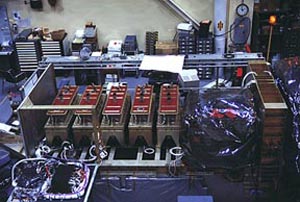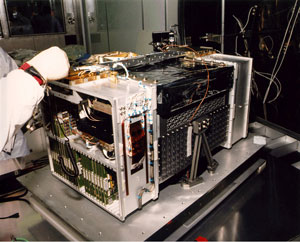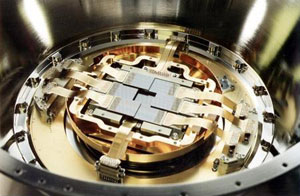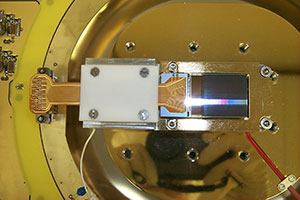X-ray Detectors - Electrical Current Detections
X-ray Detectors
Electrical Current Detections
Perhaps the most common type of X-ray detector uses an electric current to measure incoming X-rays. In this type of detector, an X-ray interacts with a material freeing an electron. That electron can rattle around in the detector and give energy to other electrons. In some materials, these electrons will have enough energy to be freed of their host atoms. In that case, applying an electric field will allow those free electrons to be collected and counted. The number of electrons collected tells you the energy that was deposited.
Below, we briefly describe some of the common types of X-ray detectors that use these cascades of electrons to detect incoming X-rays.
Proportional counters

Photo of the proportional counter array used on the Rossi X-ray Timing Explorer satellite. (Credit: NASA)
Proportional counters for X-ray astronomy use a gas-filled chamber with an arrangement of electrodes to create low- and high-electric field regions. The chamber has a "window" where X-rays enter the detector; the window is made from a material transparent to X-rays. When a photon enters the detector, it interacts with the gas through photoionization. Essentially, the incoming X-ray frees an electron from an atom of the gas. This pair of negatively charged electron and positively charged ion are called an ion pair.
The positive electrode attracts the negatively charged electron, while the negative electrode attracts the positively charged ion. As these charged particles travel through the detector toward the electrodes, they interact with other particles of gas, creating more ion pairs. By the time the original ion pair reaches the electrodes, they have caused a cascade of other electrons and ions that also arrive at the electrodes. The number of particles detected is proportional to the original X-ray which caused the cascade. (This is how a proportional counter detector gets it's name.)
The signal at the electrodes gives astronomers the energy of the incoming X-ray. In order to get position information, proportional counters generally have a large number of electrodes, dividing the detector up into small cells. Then, the ion pair will be attracted to the closest electrodes, and astronomers know which cell the X-ray entered.
The Rossi X-ray Timing Explorer is a recent X-ray astronomy mission that has used proportional counter detectors.
Microchannel Plates

Photo of the High Resolution Camera used on the Chandra X-ray Observatory. The HRC uses microchannel plates to detect X-rays. (Credit: NGST and NASA/CXC/SAO)
A microchannel plate detector consists of an array of tiny channels etched through a lead glass plate. Each channel is basically a tube that runs through the plate. The tubes are coated with a material that causes electrons to be emitted when X-rays strike it. Those electrons are accelerated down the tube by a high voltage. As they travel down the tube, they strike the tube, causing more electrons to be emitted. By the time the electrons reach the end of the tube, there are millions of electrons – a strong enough signal to be read out.
A typical microchannel plate has bout 10,000,000 closely packed channels. Those channels each have a diameter of about 10 microns. The position of the incoming X-ray can be found by pinpointing which channel the X-ray activated.
The Chandra X-ray Observatory uses a microchannel plate detector on it's High Resolution Camera.
Semiconductor Detectors

Photo of the European Photon Imaging Camera (EPIC) CCD array on XMM-Newton. (Credit: Leicester University, University of Birmingham, CEA Service d'Astrophysique Saclay and ESA)

Photo of the CCD used on Swift's X-ray Telescope (XRT). (Credit: NASA/Swift)
Semiconductor detectors work in a similar manner to proportional counters, except instead of being filled with a gas, they use a solid semiconducting material. When an X-ray enters the detector, it interacts with the semiconductor. The interaction frees an electron from a molecule of the semiconductor, creating a electron-hole pair. The "hole" is a spot in the semiconductor that is now missing an electron, so it has a net positive charge. The detector has a high voltage applied, which attracts the electrons to the negative side and the holes to the positive side. As the electron accelerates through the semiconductor, it interacts with other molecules, freeing more electrons and creating more electron-hole pairs. This cascade of electrons is detected as a pulse of electric current.
Perhaps the most common type of semiconductor detectors are charged coupled devices, also known as CCDs. This is the type of detector that are used in digital cameras, so if you have a cell phone with a camera, you have a CCD.
NuSTAR uses semiconductor detectors that use Cadmium-Zinc-Telluride semiconductors. Many X-ray astronomy missions use CCDs, like Swift's X-ray Telescope (XRT), Chandra's Advanced CCD Imaging Spectrometer (ACIS), Suzaku's X-ray Imaging spectrometer (XIS), and XMM-Newton's European Photon Imaging Camera (EPIC).
Updated: October 2013

